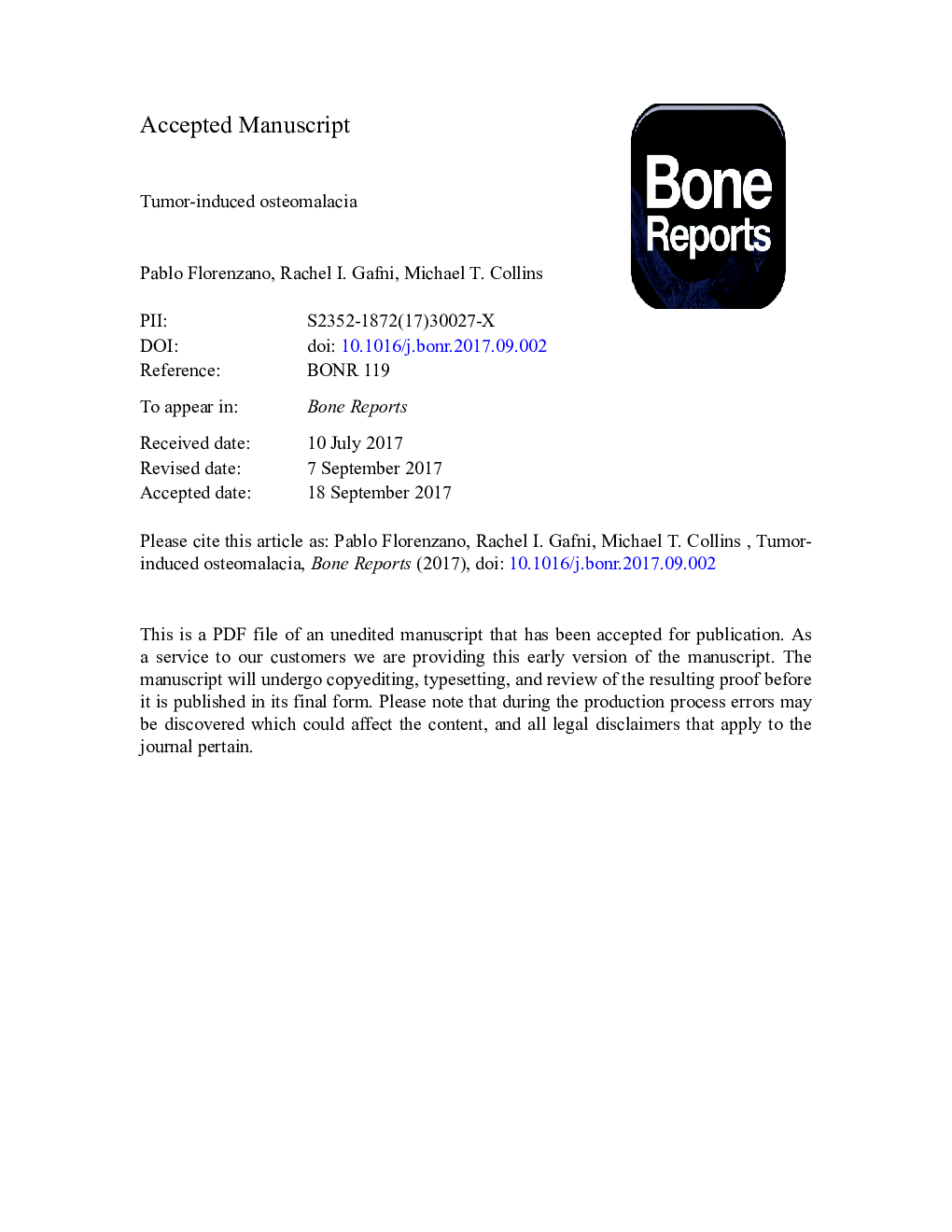| کد مقاله | کد نشریه | سال انتشار | مقاله انگلیسی | نسخه تمام متن |
|---|---|---|---|---|
| 5586714 | 1568665 | 2017 | 31 صفحه PDF | دانلود رایگان |
عنوان انگلیسی مقاله ISI
Tumor-induced osteomalacia
ترجمه فارسی عنوان
پوکی استخوان ناشی از تومور
دانلود مقاله + سفارش ترجمه
دانلود مقاله ISI انگلیسی
رایگان برای ایرانیان
کلمات کلیدی
pTHPhosphaturic mesenchymal tumorsTiOFGF1FN1FGF23FGFR1PMTTrp1,25(OH)2D - 1،25 (OH) 2DFDG-PET/CT - FDG-PET / CTMAPK - MAPKMRI - امآرآی یا تصویرسازی تشدید مغناطیسیSPECT - برشنگاری رایانهای تک فوتونی، مقطع نگاری رایانهای تک فوتونی، توموگرافی رایانهای تک فوتونی، اسپکتMagnetic resonance imaging - تصویربرداری رزونانس مغناطیسیPhosphaturic mesenchymal tumor - تومور مزانشیمی فسفاتوریکcomputerized tomography - توموگرافی کامپیوتریsingle-photon emission computed tomography - توموگرافی کامپیوتری انتشار یک تک فوتونFibroblast growth factor 1 - عامل رشد فیبروبلاست 1fibroblast growth factor 23 - فاکتور رشد فیبروبلاست 23fluorescence in situ hybridization - فلورسانس در هیبریداسیون در محلFish - ماهیparathyroid hormone - هورمون پاراتیروئیدmitogen-activated protein kinase - پروتئین کیناز فعال با mitogentumor-induced osteomalacia - پوکی استخوان ناشی از تومورFibroblast growth factor receptor-1 - گیرنده فاکتور رشد فیبروبلاست 1
موضوعات مرتبط
علوم زیستی و بیوفناوری
بیوشیمی، ژنتیک و زیست شناسی مولکولی
علوم غدد
چکیده انگلیسی
Tumor-induced osteomalacia (TIO) is a rare paraneoplastic syndrome clinically characterized by bone pain, fractures and muscle weakness. It is caused by tumoral overproduction of fibroblast growth factor 23 (FGF23) that acts primarily at the proximal renal tubule, decreasing phosphate reabsorption and 1α-hydroxylation of 25 hydroxyvitamin D, thus producing hypophosphatemia and osteomalacia. Lesions are typically small, benign mesenchymal tumors that may be found in bone or soft tissue, anywhere in the body. In up to 60% of these tumors, a fibronectin-1(FN1) and fibroblast growth factor receptor-1 (FGFR1) fusion gene has been identified that may serve as a tumoral driver. The diagnosis is established by the finding of acquired chronic hypophosphatemia due to isolated renal phosphate wasting with concomitant elevated or inappropriately normal blood levels of FGF23 and decreased or inappropriately normal 1,25-OH2-Vitamin D (1,25(OH)2D). Locating the tumor is critical, as complete removal is curative. For this purpose, a step-wise approach is recommended, starting with a thorough medical history and physical examination, followed by functional imaging. Suspicious lesions should be confirmed by anatomical imaging, and if needed, selective venous sampling with measurement of FGF23. If the tumor is not localized, or surgical resection is not possible, medical therapy with phosphate and active vitamin D is usually successful in healing the osteomalacia and reducing symptoms. However, compliance is often poor due to the frequent dosing regimen and side effects. Furthermore, careful monitoring is needed to avoid complications such us secondary/tertiary hyperparathyroidism, hypercalciuria, and nephrocalcinosis. Novel therapeutical approaches are being developed for TIO patients, such as image-guided tumor ablation and medical treatment with the anti-FGF23 monoclonal antibody KRN23 or anti FGFR medications. The case of a patient with TIO is presented to illustrate the importance of adequate and appropriate evaluation of patients with bone pain and hypophosphatemia, as well as an step-wise localization study of patients with suspected TIO.
ناشر
Database: Elsevier - ScienceDirect (ساینس دایرکت)
Journal: Bone Reports - Volume 7, December 2017, Pages 90-97
Journal: Bone Reports - Volume 7, December 2017, Pages 90-97
نویسندگان
Pablo Florenzano, Rachel I. Gafni, Michael T. Collins,
